-

人教版高中英语必修3Festivals around the World说课稿3篇
Teaching plan for Unit 1 book3Good morning, teachers. It’s my great pleasure to be here because I can share my lesson with you and I can learn a lot from it. I’ll begin my lesson from the following four parts, the teaching material, the teaching methods, the studying methods and the teaching procedure.Firstly, let me talk about the teaching material. The content of my lesson is the reading passage festivals and celebrations of Unit 1 Festivals around the world. This passage is about festivals and celebrations. By studying this passage, we’ll enable the students to know that festivals exit everywhere, and many of festivals in different countries celebrate similar ideas. As we all know, the reading passage is the center of each unit. If the Ss can learn it well, it will be helpful to make the Ss learn the rest of this unit.After studying the teaching material, I think the teaching aims are as the followings:1. Knowledge aims:(1) The Ss can master the usage of the important words andexpressions.(2)The Ss can use the __________________ (grammar) in the proper situation.Make students know about the festivals all over the world and the detail of the festivals, such as origin, content, and the date of the holiday festivals.2. Ability aims:(1) Students can talk about festivals and celebrations in English(2) To improve the student’s reading ability, especially their skimming and scanning ability.3. Emotion aims:Make the Ss know about the foreign festivals, and respect other countries’ custom.Next, let’s come to the important points and the difficult points.The important point is how to make the Ss understand the text better and the difficult point is how can they talk about it. secondly, Teaching Methods:1. task-based Language Teaching2. Computer assisted language teaching.3. question-and–answer methodThirdly, Studying Methods:

人教版高中英语必修4Theme parks说课稿3篇
The oldest and the most popular park in the worldenjoy the exciting activities thereget close to the life-size cartoon characters like Mickey Mouse and Donald Duck Step 3 Pre-reading1.What do you suppose a theme park is ?2.What do you think you can see in a theme park?(1.It is a kind of amusement park which has a certain theme – that the whole park is based on. 2.buildings, castles, statues, rare animals and birds, and so on.) Step 4 Reading ----- Theme Parks –---- Fun and More Than Fun1.Predict : Read the title and the pictures on P. 34 and PredictWhat is the meaning of the title “Theme Park – Fun and more than fun”?(The title means that theme parks are fun to visit, but that they can also be educational and can offer useful information.)2.Skimming Fast read and answer:What activities can we take in a theme park?Amusement park: Bumper car Merry-go-round slide bungee jumping Free-fall rides Horror films Pirate ship Ferris wheel roller coaster3.Scanning Read again and you will find various theme parks are mentioned in the passage . Then what are they ?Theme parks: Sports theme park History theme park Culture theme park Marine or Ocean theme Park Future park Science theme park Disneyland4.Careful reading and find the main idea of each paragraph:THEME PARKS---- entertaining/ educationalPara.1 Traditional parks are places to go for relaxation and to have time away from our busy lives.Para.2 Theme parks are different They’re large and full of things to do, see and buy.Para.3 Theme parks are built around a single idea or theme. One example is a sports park.Para.4 Another kind of theme park is historical more and cultural and can be educational.Para.5 Disneylandwas the first theme park. It is based on the fantasy life and characters of Disney’s films.Para.6 Some examples of educational theme parks include sea world parks and science parks.

人教版高中英语必修4Working The Land说课稿3篇
Knowledge objectives:(1) to make Ss grasp the usage of words, expressions and sentence structures: statistics, struggle, thanks to, rid of, some patterns for persuasion, the “ing” form as subject and object;(2)to use learnt knowledge to persuade sb.Ability objectives:(1) to develop Ss’ reading skills(skimming, scanning, word guessing);(2) to improve Ss’ speaking, communicating and cooperating skills.Emotional objectives:to make Ss know the contribution of Yuan,and learn his spirit and his simple life time.Teaching important and difficult points:(1) some words, expressions and sentence structures mentioned above;(2)the content of the text;(3)training their reading and speaking skills.Teaching methods: CLT, TBLT,QT.Learning strategies: CLS, QLS, TBLS.Teaching procedures:Step 1 lead-in: (1) teacher plays a piece of recent news from CCTV about the harvest of the super hybrid rice, and ask students whether they know Yuan or not, and talk about him and his contribution.(2)Brain storm: let Ss describe Yuan in their minds including his appearance, his living condition and so on.Step 2 fast reading tasks:(1)teacher introduces Yuan and super hybrid rice(2)make Ss read the text as fast as possible with questions. Such as: what’s the general ideaof this passage? What’s Yuan’ dream? (skimming and scanning skill)Step 3 intensive reading tasks(1)let Ss read the text silently, find topic sentence of each paragraph and draw the difficult sentences and the knowledge what they don’t understand.(words guessing)(2)teacher and Ss talk about the important words, expressions and sentences together, and ask Ss to retell the content of the text.(summarizing and paraphrasing)(3)teacher summarize this part.(4) read again following the courseware.

人教版高中英语必修3The million pound bank note说课稿3篇
在接下来的细读环节,我套用了高考对阅读理解的考查方式设置了5个问题,分别为三个推理判断题,一个细节题和一个主旨大意题。学生需要对文章的内容进行分析、归纳、推理、猜测等高级思维活动才能做出正确的回答。【设计意图】这一过程是对学生进行细读的训练,培养学生获取特定信息和挖掘文章深层次信息的能力。第三环节:Intensive-reading (精读) 15′第三个环节精读,既是最重要的环节,也是突破本课重难点的关键。首先,让学生思考剧本中人物看到百万英镑前后的态度发生了怎样的变化。其次,让学生仔细阅读文章,找出可以表现人物态度变化的具体的语言和动作。最后,让学生总结人物的态度发生变化的根本原因是什么,从而引出Money Talks, 供学生思考。【设计意图】通过一系列的活动培养学生学习从人物的语言和动作探究人物的心理,使学生进一步体会戏剧语言的魅力,从而对文章背后所反映的社会问题进行思考,也为下一步的讨论环节做好铺垫。

人教版高中英语必修5Great scientists说课稿4篇
通过写文章梗概,培养学生综合运用语言的能力,学习用恰当的英语描述科学家的故事。这是本课的教学难点。教师可以使用完形填空的方式来帮助学生整理语篇,从而来降低难度。本课的教学重点的突破方法是:在阅读前,让学生初步了解得出科学观点所需要的基本程序,从而轻松而自然地导入文章的阅读;在阅读过程中,由易到难设计快速阅读和精读的问题,层层推进各种阅读活动,让学生对阅读内容从整体感知到细节理解,最后深层读懂整篇文章,同时加强阅读策略的指导,让每个学生都主动参与课堂教学活动,最终达到提高阅读能力的目的。Step 4 Post-readingGroup Activities四人小组共同合作,在老师的适当指导下,就以下2个问题展开讨论,让学生就所知、所学、所感和所想融入话题,然后抽若干同学代表作小组发言。1. What do you think about John Snow, and what should we learn from him?2. Cholera was 19th century disease, which two diseases are similar to cholera today? Why?

人教版高中英语必修5Life in the Future说课稿5篇
Good afternoon, everyone. It’s my great pleasure to be here sharing my lesson with you. The content of my lesson is Senior English for China Book5 Unit 3 Life in the Future. I’ll be ready to begin this lesson from six parts: Analysis of the teaching material, Analysis of the students, Teaching aims and important and difficult points, Teaching methods and aids, Teaching procedures, and Blackboard design. First, let me talk about the teaching material.Part 1 Analysis of the Teaching Material:This unit is about what human beings’ life will be like in about one thousand years. By studying of this unit, we’ll Enable the students to know the changes in humans’ life and some new inventions bringing about the change and develop the interest in science. This lesson plays an important part in the English teaching in this unit. This is an important lesson in Book Five. From this lesson, it starts asking the Ss to grasp contents of each passage. Therefore, this lesson is in the important position of the teaching material. If the Ss can learn it well, it will be helpful to make the Ss learn the rest of this unit.Part 2 Analysis of the SsAs Senior2 Ss, they are at different levels of English fluency, some of them have lost interest in English. So during the lesson, I arrange a variety of activities to let all of them join in to attract their interest and let them be confident and taste the joy of success.

人教版高中英语必修5The United Kingdom说课稿4篇
Teaching Aims:Knowledge 1. Get the students to learn the useful new words and expressions in this section. Aims:2. Let the students learn about how the UK was formed and the four groups of invaders.1. Develop students’ reading ability and let them learn different Ability reading skills. Aims:2. Enable students to learn to talk about the United Kingdom and the Union Jack Emotional 1. Let students know more about the UK2. Develop students’ sense of cooperative learning Aims:Teaching Important Points:1. Let the students learn about the countries of the United Kingdom and the Union Jack2. Get the students to read the passage and know about how the UK was formed and the four groups of invaders.3. Have the students learn different reading skills.Teaching Difficult Ponts:1. Develop students’ reading ability.2. Enable students to talk about the United Kingdom and the Union Jack.3. Let students learn how the UK was formed geographically and historically.Teaching Methods:Showing pictures, asking, exercising, listening, reading etc.Teaching Aids:A computer,a projector and a blackboard.Teaching Procedures: 1) Show a map of the world, ask students the following questions:Where is the UK?What’s the full name of the UK?2) Ask the students work in pairs to do the quiz on Page 9.Do you want to test how many things you know about the United Kingdom? Let’s have a small test.Using the map on P9, students answer the following questions:?How many countries does the UK consist of? What are they??England is divided into three main areas. Do you know what they are? 1) Scanning (10Minutes )Let the students hold the questions asked in pre-reading and read the passagequickly and then let them do the following exercise.Join lines to the right answer.
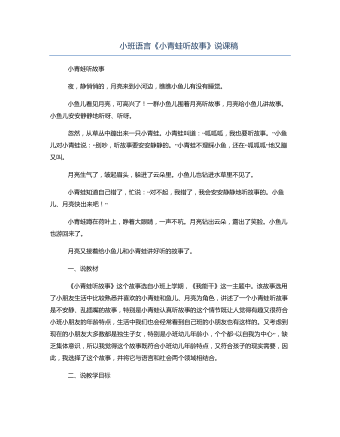
小班语言《小青蛙听故事》说课稿
小青蛙听故事夜,静悄悄的,月亮来到小河边,瞧瞧小鱼儿有没有睡觉。小鱼儿看见月亮,可高兴了!一群小鱼儿围着月亮听故事,月亮给小鱼儿讲故事。小鱼儿安安静静地听呀、听呀。忽然,从草丛中蹦出来一只小青蛙。小青蛙叫道:“呱呱呱,我也要听故事。”小鱼儿对小青蛙说:“别吵,听故事要安安静静的。”小青蛙不理睬小鱼,还在“呱呱呱”地又蹦又叫。月亮生气了,皱起眉头,躲进了云朵里。小鱼儿也钻进水草里不见了。小青蛙知道自己错了,忙说:“对不起,我错了,我会安安静静地听故事的。小鱼儿、月亮快出来吧!”小青蛙蹲在荷叶上,睁着大眼睛,一声不吭。月亮钻出云朵,露出了笑脸。小鱼儿也游回来了。月亮又接着给小鱼儿和小青蛙讲好听的故事了。
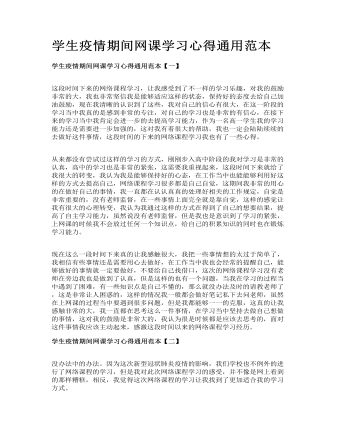
学生疫情期间网课学习心得通用范本
从来都没有尝试过这样的学习的方式,刚刚步入高中阶段的我对学习是非常的认真,高中的学习也是非常的紧张,这需要我重视起来,这段时间下来就给了我很大的转变,我认为我是能够保持好的心态,在工作当中也能能够利用好这样的方式去提高自己,网络课程学习很多都是自己自觉,这期间我非常的用心的在做好自己的事情,我一直都在认认真真的处理好相关的工作规定,自觉是非常重要的,没有老师监督,在一些事情上面完全就是靠自觉,这样的感觉让我有很大的心理转变,我认为我通过这样的方式在得到了自己的想要结果,提高了自主学习能力,虽然说没有老师监督,但是我也是意识到了学习的紧张,上网课的时候我不会放过任何一个知识点,给自己的积累知识的同时也在锻炼学习能力。
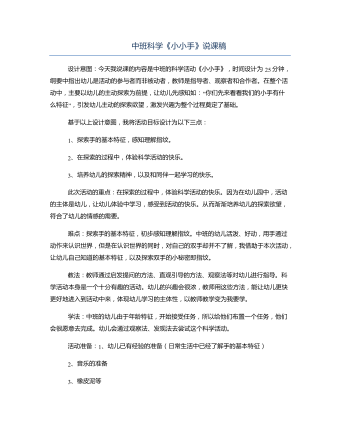
中班科学《小小手》说课稿
设计意图:今天我说课的内容是中班的科学活动《小小手》,时间设计为25分钟,纲要中指出幼儿是活动的参与者而非被动者,教师是指导者、观察者和合作者。在整个活动中,主要以幼儿的主动探索为前提,让幼儿先感知如:“你们先来看看我们的小手有什么特征”,引发幼儿主动的探索欲望,激发兴趣为整个过程奠定了基础。基于以上设计意图,我将活动目标设计为以下三点:1、探索手的基本特征,感知理解指纹。2、在探索的过程中,体验科学活动的快乐。3、培养幼儿的探索精神,以及和同伴一起学习的快乐。
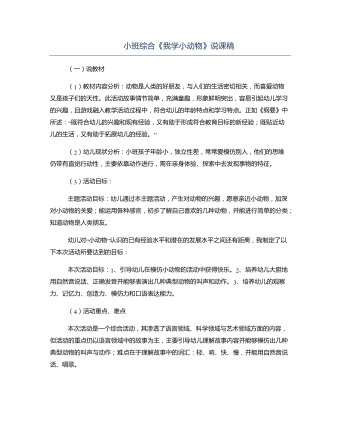
小班综合《我学小动物》说课稿
(1)教材内容分析:动物是人类的好朋友,与人们的生活密切相关,而喜爱动物又是孩子们的天性。此活动故事情节简单,充满童趣,形象鲜明突出,容易引起幼儿学习的兴趣,且游戏融入教学活动过程中,符合幼儿的年龄特点和学习特点。正如《纲要》中所述:“既符合幼儿的兴趣和现有经验,又有助于形成符合教育目标的新经验;既贴近幼儿的生活,又有助于拓展幼儿的经验。”(2)幼儿现状分析:小班孩子年龄小,独立性差,常常爱模仿别人,他们的思维仍带有直觉行动性,主要依靠动作进行,需在亲身体验、探索中去发现事物的特征。(3)活动目标:主题活动目标:幼儿通过本主题活动,产生对动物的兴趣,愿意亲近小动物,加深对小动物的关爱;能运用各种感官,初步了解自己喜欢的几种动物,并能进行简单的分类;知道动物是人类朋友。
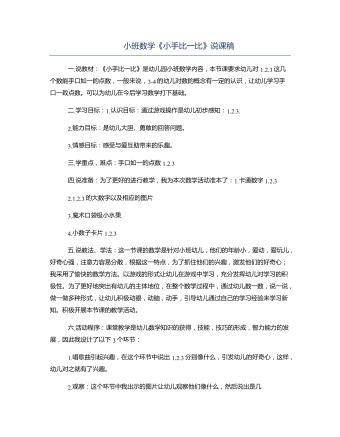
小班数学《小手比一比》说课稿
说教法、学法:这一节课的数学是针对小班幼儿,他们的年龄小,爱动,爱玩儿,好奇心强,注意力容易分散,根据这一特点,为了抓住他们的兴趣,激发他们的好奇心;我采用了愉快的数学方法。以游戏的形式让幼儿在游戏中学习,充分发挥幼儿对学习的积极性。为了更好地突出有幼儿的主体地位,在整个数学过程中,通过幼儿数一数,说一说,做一做多种形式,让幼儿积极动眼,动脑,动手,引导幼儿通过自己的学习经验来学习新知。积极开展本节课的教学活动。课堂教学是幼儿数学知识的获得,技能,技巧的形成,智力能力的发展,因此我设计了以下3个环节:1.唱歌曲引起兴趣,在这个环节中说出1.2.3分别像什么,引发幼儿的好奇心,这样,幼儿对之就有了兴趣。2.观察:这个环节中我出示的图片让幼儿观察他们像什么,然后说出是几
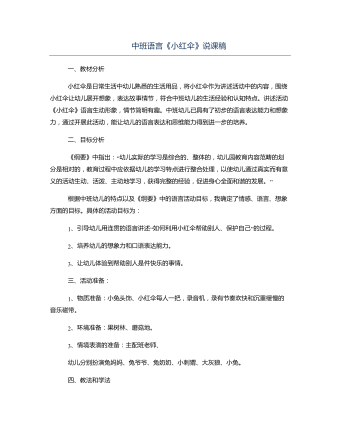
中班语言《小红伞》说课稿
在区角投放相关头饰让孩子继续表演、讲述故事内容,也可以将故事内容画出来,装订成小图书,让孩子讲述,进一步培养幼儿对讲述活动的兴趣。通过角色的扮演、语言的表述将幼儿带入故事情境中,一下子拉近了师生之间的情感距离,自然、亲切,再以过渡性的提问引出小红伞直接揭示课题,也为下一个环节作一个良好的铺垫。情境体验的环节中教者以音乐贯穿于情境一、情境二、情境三中,一是发挥音乐的教育功能,二是让幼儿体验到帮助别人、解决问题的喜悦心情。通过看看、想想、说说,孩子用多种感官参与活动,教者则发挥了引导者的作用。孩子的想法是多种多样的,教师都给予积极的评价。如果有孩子能提到讲述中的内容,就请他表演情境;反之,情境二的预设,也为下一个讲述内容作准备。心理学研究表明:视听结合,感知效果最佳。情境二所提供的视觉刺激和听觉刺激作用于幼儿的眼、耳,颇有新意,能牢牢抓住孩子兴趣,促进其思维的发展,提高了对讲述内容的记忆效果。
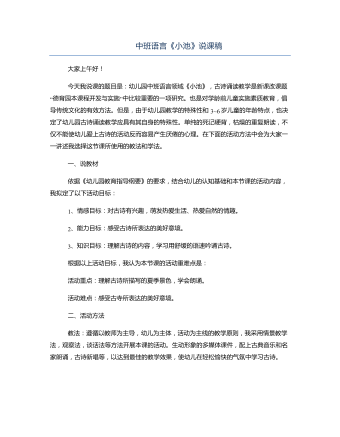
中班语言《小池》说课稿
今天我说课的题目是:幼儿园中班语言领域《小池》,古诗诵读教学是新课改课题“德育园本课程开发与实施”中比较重要的一项研究。也是对学龄前儿童实施素质教育,倡导传统文化的有效方法。但是,由于幼儿园教学的特殊性和3~6岁儿童的年龄特点,也决定了幼儿园古诗诵读教学应具有其自身的特殊性。单纯的死记硬背,枯燥的重复朗读,不仅不能使幼儿爱上古诗的活动反而容易产生厌倦的心理。在下面的活动方法中会为大家一一讲述我选择这节课所使用的教法和学法。
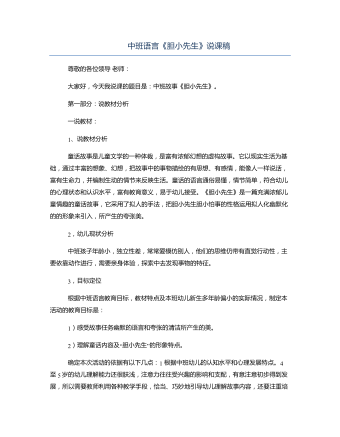
中班语言《胆小先生》说课稿
童话故事是儿童文学的一种体裁,是富有浓郁幻想的虚构故事。它以现实生活为基础,通过丰富的想象、幻想,把故事中的事物描绘的有思想、有感情,能像人一样说话,富有生命力,并编制生动的情节来反映生活。童话的语言通俗易懂,情节简单,符合幼儿的心理状态和认识水平,富有教育意义,易于幼儿接受。《胆小先生》是一篇充满浓郁儿童情趣的童话故事,它采用了拟人的手法,把胆小先生胆小怕事的性格运用拟人化幽默化的的形象来引入,所产生的夸张美。
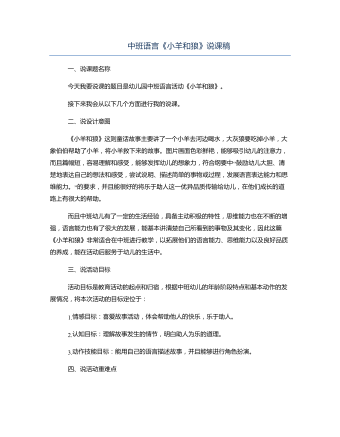
中班语言《小羊和狼》说课稿
《小羊和狼》这则童话故事主要讲了一个小羊去河边喝水,大灰狼要吃掉小羊,大象伯伯帮助了小羊,将小羊救下来的故事。图片画面色彩鲜艳,能够吸引幼儿的注意力,而且篇幅短,容易理解和感受,能够发挥幼儿的想象力,符合纲要中“鼓励幼儿大胆、清楚地表达自己的想法和感受,尝试说明、描述简单的事物或过程,发展语言表达能力和思维能力。”的要求,并且能很好的将乐于助人这一优异品质传输给幼儿,在他们成长的道路上有很大的帮助。而且中班幼儿有了一定的生活经验,具备主动积极的特性,思维能力也在不断的增强,语言能力也有了很大的发展,能基本讲清楚自己所看到的事物及其变化,因此这篇《小羊和狼》非常适合在中班进行教学,以拓展他们的语言能力、思维能力以及良好品质的养成,能在活动后服务于幼儿的生活中。
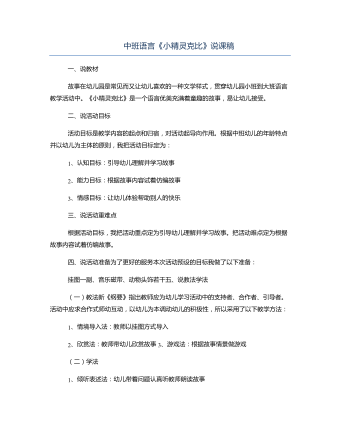
中班语言《小精灵克比》说课稿
说动过程为了讲清重点突破难点,从而达到教学目标,我把活动设计如下操作:1、激发兴趣,教师出示故事挂图,让幼儿欣赏并提出问题“小朋友,挂图上有什么?他们都在做什么?”教师引导幼儿观察挂图并回答问题从而引出课题。2、理解并欣赏故事,突破重点教师播放故事磁带让幼儿认真欣赏;教师示范讲故事情景,让幼儿感受故事中帮助他人的快乐,并试着引导幼儿理解故事内容,提出故事内容相关的问题“故事的名称叫什么?都讲了哪些动物?小精灵克比是这样帮助他们的?3、学习故事,试着根据故事内容仿编故事,突破难点教师将故事内容进行分段理解,一句一句教幼儿理解并学习故事内容。在学习故事后引导幼儿试着大胆仿编故事。教师和幼儿合作一起完成,感受师幼合作的快乐。4、游戏表演在学习完故事后进行故事情境表演,教师说游戏规则,幼儿带动物头饰进行情境表演,将课堂气氛推向高潮。
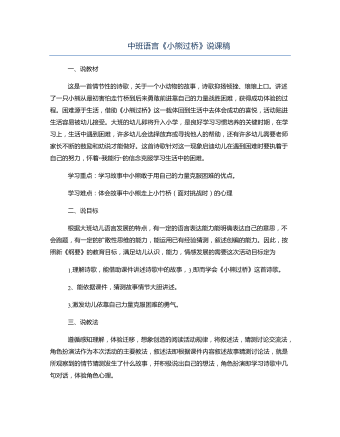
中班语言《小熊过桥》说课稿
这是一首情节性的诗歌,关于一个小动物的故事,诗歌抑扬顿挫、琅琅上口。讲述了一只小熊从最初害怕走竹桥到后来勇敢前进靠自己的力量战胜困难,获得成功体验的过程。困难源于生活,借助《小熊过桥》这一载体回到生活中去体会成功的喜悦,活动贴进生活容易被幼儿接受。大班的幼儿即将升入小学,是良好学习习惯培养的关键时期,在学习上,生活中遇到困难,许多幼儿会选择放弃或寻找他人的帮助,还有许多幼儿需要老师家长不断的鼓励和劝说才能做好。这首诗歌针对这一现象启迪幼儿在遇到困难时要执着于自己的努力,怀着“我能行”的信念克服学习生活中的困难。
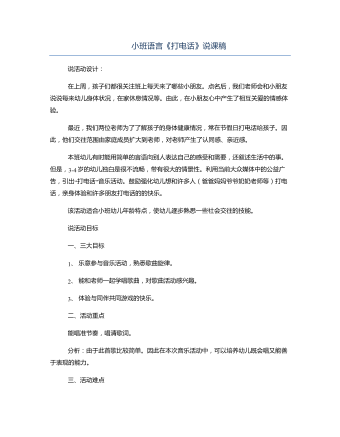
小班语言《打电话》说课稿
在上周,孩子们都很关注班上每天来了哪些小朋友。点名后,我们老师会和小朋友说说每来幼儿身体状况,在家休息情况等。由此,在小朋友心中产生了相互关爱的情感体验。最近,我们两位老师为了了解孩子的身体健康情况,常在节假日打电话给孩子。因此,他们交往范围由家庭成员扩大到老师,对老师产生了认同感、亲近感。本班幼儿有时能用简单的言语向别人表达自己的感受和需要,还叙述生活中的事。但是,3-4岁的幼儿独白是很不流畅,带有很大的情景性。利用当前大众媒体中的公益广告,引出“打电话”音乐活动。鼓励强化幼儿想和许多人(爸爸妈妈爷爷奶奶老师等)打电话,亲身体验和许多朋友打电话的的快乐。
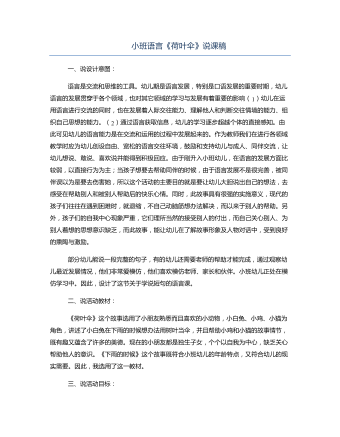
小班语言《荷叶伞》说课稿
语言是交流和思维的工具。幼儿期是语言发展,特别是口语发展的重要时期,幼儿语言的发展贯穿于各个领域,也对其它领域的学习与发展有着重要的影响(1)幼儿在运用语言进行交流的同时,也在发展着人际交往能力、理解他人和判断交往情境的能力、组织自己思想的能力。(2)通过语言获取信息,幼儿的学习逐步超越个体的直接感知。由此可见幼儿的语言能力是在交流和运用的过程中发展起来的。作为教师我们在进行各领域教学时应为幼儿创设自由、宽松的语言交往环境,鼓励和支持幼儿与成人、同伴交流,让幼儿想说、敢说、喜欢说并能得到积极回应。由于刚升入小班幼儿,在语言的发展方面比较弱,以直接行为为主;当孩子想要去帮助同伴的时候,由于语言发展不是很完善,被同伴误以为是要去伤害她,所以这个活动的主要目的就是要让幼儿大胆说出自己的想法,去感受在帮助别人和被别人帮助后的快乐心情。同时,此故事具有很强的实施意义,现代的孩子们往往在遇到困难时,就退缩,不自己动脑筋想办法解决,而以来于别人的帮助。另外,孩子们的自我中心现象严重,它们理所当然的接受别人的付出,而自己关心别人、为别人着想的思想意识缺乏,而此故事,能让幼儿在了解故事形象及人物对话中,受到良好的熏陶与激励。

